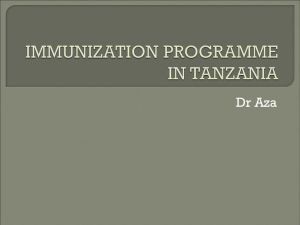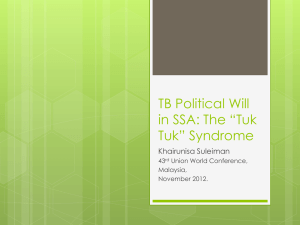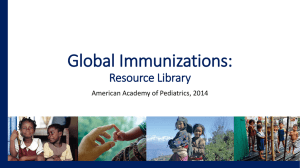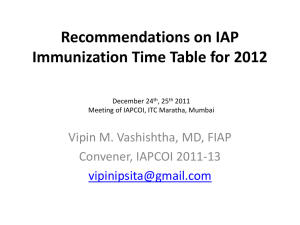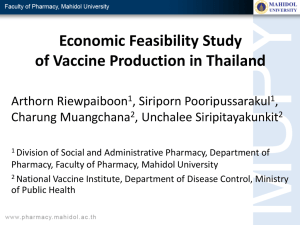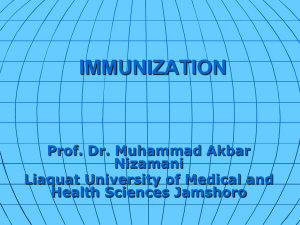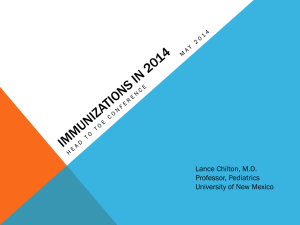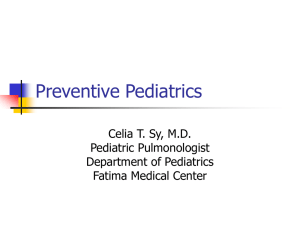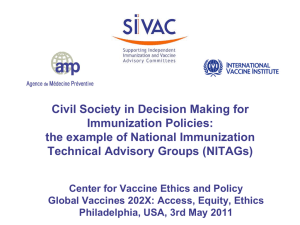Immunizations
advertisement
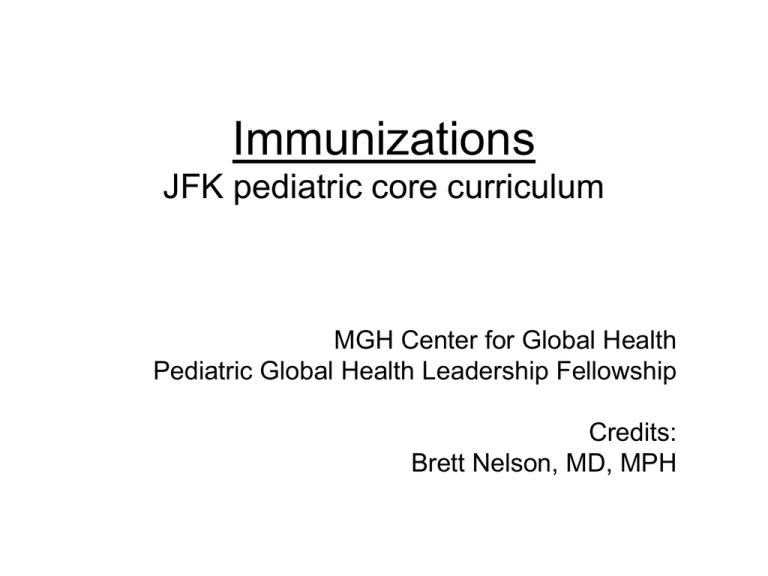
Immunizations JFK pediatric core curriculum MGH Center for Global Health Pediatric Global Health Leadership Fellowship Credits: Brett Nelson, MD, MPH Discussion outline • • • • • • Success of immunizations Still significant room for improvement Immunization schedules Administration of vaccines Contraindications Specific vaccines Immunizations save lives Globally, immunizations save the lives of approximately 3 million people each year Vaccines are safe • Immunization is among safest of modern medical interventions • Vaccines are easier and safer to administer than ever before • Being immunized is much safer than risking infection and disease Immunization can save money • Immunization is one of the most cost-effective health interventions • Investing in vaccines SAVES more money than it costs Immunization can protect the unprotected • When immunization coverage is high, it can prevent viruses and bacteria from circulating • The more children in a community that are fully immunized, the safer everyone is • Unfortunately, …. 34 million children are not fully immunized 2.3 million still die each year Diseases reappear when coverage drops Immunization coverage in Liberia Significant success over the last decade http://www.who.int/vaccines/globalsummary/immunization/countryprofileresult.cfm Liberia immunization schedule (coming soon?) http://www.who.int/vaccines/globalsummary/immunization/ScheduleSelect.cfm WHO EPI schedule by age WHO Pocket Book of Hospital Care for Children. Page 297. Administering vaccines • Most doses for children are 0.5ml IM or SC • Sites of IM/SC administration: – <18months: anterolateral thigh – Toddlers: anterolateral thigh or deltoid – Older children: deltoid • Give IM: – DTP, Hib, Hep B • Give SC: – Measles, yellow fever Contraindications to immunizations • Important to immunize all children, including those sick and malnourished, unless there are contraindications • Common side effects to vaccines: – Pain, local swelling, fever, fussiness, drowsiness, vomiting, anorexia • General contraindications to any vaccine: – History of anaphylaxis to that vaccine or vaccine component – Current moderate or severe illness regardless of fever Specific contraindications • BCG and yellow fever – Do not give BCG or yellow fever vaccines to child with symptomatic HIV/AIDS – But do give BCG and yellow fever vaccines to a child with asymptomatic HIV infection • DPT – Do not give DPT-2 or -3 to child who had seizures or shock within 3 days of previous DPT dose (possible encephalopathy to pertussis component)* – Do not give DPT to child with poorly controlled seizures or active CNS disease* *(If available, can give DT vaccine with no pertussis component) • OPV – A child with diarrhea who is due for OPV should be given OPV – However, this dose should not be counted in schedule – Make note on child’s immunization record that it coincided with diarrhea, so that health worker will know this and give an extra dose BCG vaccine • TB currently accounts for more deaths than any other infectious disease – Almost 3 million people a year, including nearly 300 000 children – Over 50 million people infected with drug-resistant strains • BCG (Bacille Calmette-Guérin) is a live vaccine – Administered intradermally (produces small raised "bleb“) at birth • Most widely used of all EPI vaccines – In 1997, almost 90% of the world’s children were immunized with BCG – 50-80% effective against most serious forms of childhood TB: miliary TB and TB meningitis – Offers some protection against leprosy – Uncertain protection against adult forms of TB • WHO recommendations: – In countries with high incidence of TB, immunize infants and children <5 years with single dose of BCG – Where definable high-risk population, countries may limit BCG to infants (such is schedule in Liberia) – Booster doses not recommended Oral polio vaccine • 2 kinds of polio vaccine – Inactivated injectable polio vaccine (IPV) originally developed in 1955 by Dr Jonas Salk – Live attenuated oral polio vaccine (OPV) developed by Dr Albert Sabin in 1961 – Both highly effective against all 3 types of poliovirus • OPV is vaccine of choice for eradication of poliomyelitis – 5x less expensive – Easier to administer (PO vs IM) – Most importantly, induces immunity in gut, where poliovirus multiplies • IPV provides individual protection against polio paralysis but not capable of preventing spread of wild poliovirus since induces very low immunity in gut • WHO recommendations: – 4 doses of OPV before first birthday (birth, 6, 10, 14 weeks) – However, supplementary doses are given during National Immunization Days to achieve eradication DTP vaccine • Combination vaccine against diphtheria, tetanus, and pertussis (whooping cough) • Given IM in 3 doses, at least 4 weeks apart (6, 10, 14 weeks) • Variations: – – – – DT (full diphtheria and tetanus toxoid, but no pertussis) Td (tetanus toxoid and reduced diphtheria; for adults) TT (tetanus toxoid alone; for women of childbearing age) Some countries have substituted acellular pertussis vaccine (aP) for whole-cell pertussis component (wP) – Some manufacturers have added Hepatitis B and/or Hib vaccine to simplify administration and reduce costs Hepatitis B vaccine • >2 billion people alive today have been infected with hepatitis B virus – Of these, ~350 million remain chronically infected, can transmit the infection, and can develop liver cirrhosis or cancer – Every year, ~4 million acute clinical cases of hepatitis B and ~1 million deaths – Primary liver cancer caused by hepatitis B is now one of principal causes of cancer death in many parts of Africa, Asia, and Pacific Basin • Globally, child-to-child and mother-to-child transmission accounts for majority of infections and carriers – Also transmitted through sexual contact, unsterile needles or other medical equipment, infected blood products, skin piercing • Vaccine given IM in 3 doses, at least 4 weeks apart (6, 10, 14 weeks) – Same schedule as DTP • Although vaccine price has fallen, still more expensive than traditional EPI vaccines -- many developing countries cannot afford Hib vaccine • Haemophilus influenzae type b (Hib) causes serious bacterial infections – Meningitis, pneumonia, and infections of blood, bones, and joints (does not cause influenza) – ~3 million serious illnesses and 386,000 deaths each year – Most common between 4-18 months, but can occur in older children – Leaves 15-35% of survivors with permanent disabilities such as mental retardation or deafness • Vaccine available alone or combined with DTP or hepatitis B (e.g. DTwPHibHep) • WHO recommendations: – 3 doses given IM at 6, 10, and 14 weeks ("where resources permit its use and burden of disease is established“) Yellow fever vaccine • Yellow fever is untreatable, viral, hemorrhagic disease, transmitted by mosquitoes, with high fatality rate (30,000 deaths/year) • Yellow fever and measles vaccines are similar in nature and both administered SC at 9 months • WHO recommendations: – 1 dose SC at 9 months for all infants in ~45 countries comprising yellow fever belt of Africa and South America – Re-immunization not indicated as vaccine thought to produce virtually life-long immunity – (However, travelers to these countries require vaccine every 10 years) Measles vaccine • Among vaccine-preventable diseases, measles remains the leading cause of child deaths – Nearly 1 million deaths every year, mainly in developing countries – However, even eradication efforts in developed countries like the U.S. have not been successful • Live attenuated vaccine • WHO recommendations: – Like yellow fever, 1 dose given SC at 9 months – Where >15% of measles cases and deaths occur before 9 months of age, give extra dose of measles vaccine at 6 months, then routine dose at 9 months – Also give extra measles dose for infants at high risk: infants in refugee camps, admitted to hospitals, HIV-positive, and affected by disasters or measles outbreaks – Oral Vitamin A drops often given at same time as measles vaccine to prevent blindness and reduce measles mortality Conclusions and implications • Vaccines are among safest and most effective medical interventions • Ensure up-to-date immunization status – Check records with each patient encounter – Give missing vaccines to hospitalized patients prior to discharge • One last review: References • Children’s Vaccine Program, Global Alliance of Vaccines and Immunizations. www.childrensvaccine.org • Immunization Action Coalition. http://immunize.org/catg.d/p2020.pdf • WHO. By-country vaccine schedule. www.who.int/vaccines/globalsummary/immunization/ScheduleSelect .cfm • WHO. Expanded programme on immunization – overview. http://wbln0018.worldbank.org/HDNet/HDdocs.nsf/0/6b9066a4c849 16ec8525676a004d6c5e?OpenDocument • WHO. Liberia reported immunization coverage. http://www.who.int/vaccines/globalsummary/immunization/countrypr ofileresult.cfm • WHO. Pocket Book of Hospital Care for Children. http://www.who.int/child_adolescent_health/documents/9241546700 /en/index.html
